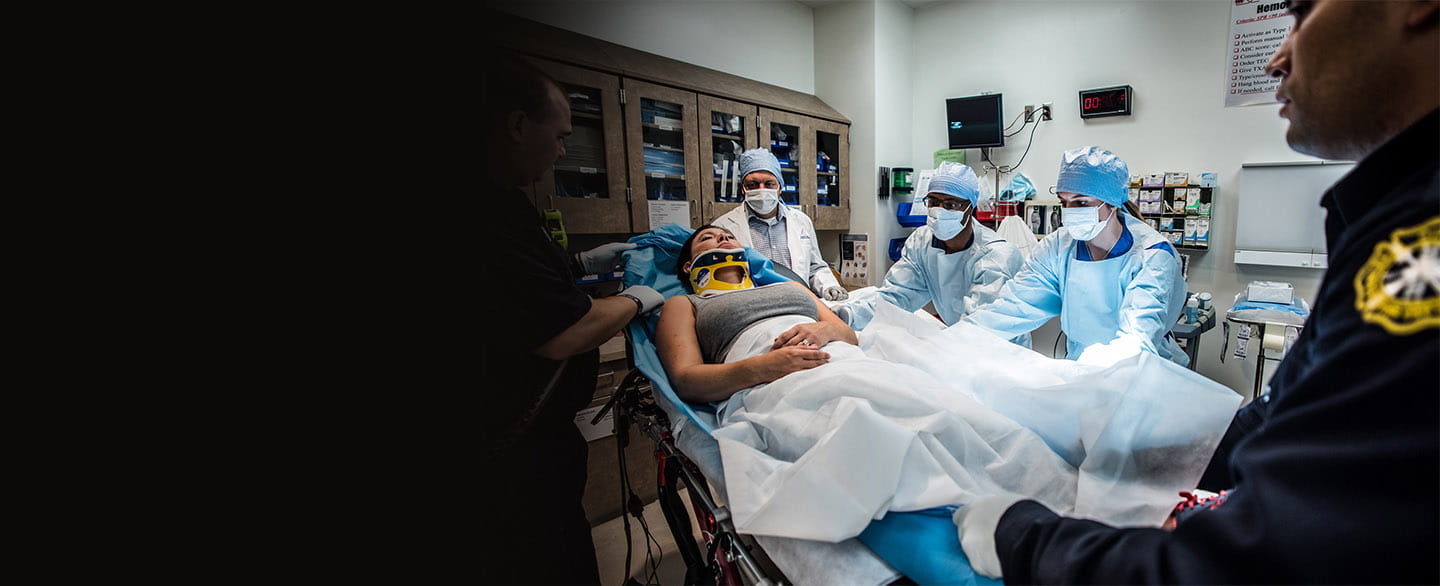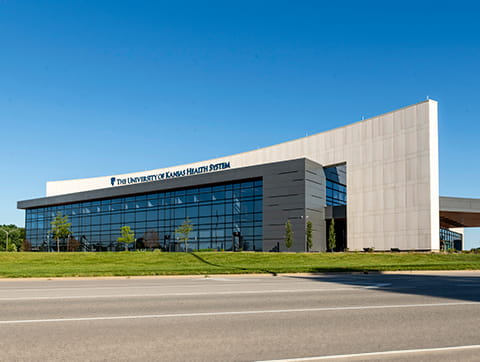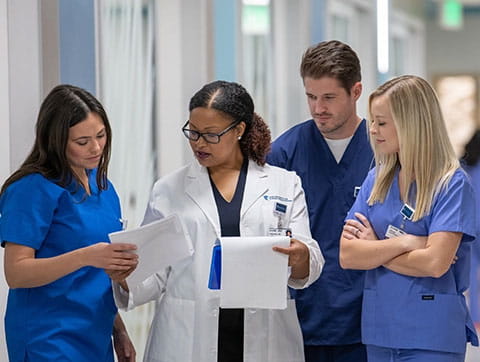- Home
- Conditions and Care
- Center
- Level I Trauma Center
- Resources
- Injury Prevention Programs
Trauma Center

Injury Prevention Programs
As the region’s most experienced, nationally verified Level I Trauma Center, our commitment to trauma research and education is offered to the community. With the No. 1 cause of death for those ages 1 to 44 being a form of trauma, prevention programs are a key asset to the surrounding communities.
The following programs can be presented to any group and are appropriate for schools, churches and civil groups.
Stop the Bleed® course
Stop the Bleed® is a free, 1-hour course designed to teach participants how to recognize and respond to life-threatening bleeding. We cover key lifesaving techniques such as applying direct pressure, packing a wound and proper tourniquet use. No medical background is needed to participate in the course. We offer the course in both English and Spanish. We will travel to you to deliver the training. Contact our team to request a Stop the Bleed class for your workplace, school, club, organization or other setting. Email BDiaz2@KUMC.edu or TraumaEducation@KUMC.edu or call 913-588-6536.
During this National Trauma month of May, we are looking at a lot of different ways to educate and promote the great work of our trauma teams. Bre Diaz is here with a little show and tell today. She is a trauma education specialist and program outreach coordinator with the health system. Thank you for coming in. Thank you for having me.
Now you have been with the health system for about four years now. Tell us your role here before you came to this demonstration. Sure. So I was a nurse in the Emergency Department here at The University of Kansas Health System for about four years. I was a board-certified trauma nurse there. Ultrasound-guided, trained nurse as well with IVs. And then I was also the triage council co-chair.
So your career life is trauma. And now you are here today to show us how to Stop The Bleed, which is a program and outreach program that you're involved in. Yes. So the Stop The Bleed program was actually, started after the Sandy Hook Elementary School shooting. So if you remember the Sandy Hook Elementary School shooting, there were 26 teachers and children who died that day.
And a trauma surgeon, Dr. Lenworth Jacobs, took it upon himself to review those autopsies, and he determined that almost every single student and teacher that died that day could have survived, had someone there known how to Stop The Bleed. They just bled out. There were no direct kill shots. And so stop the bleed can save lives.
Why don't you show me how to stop the bleed? You've got a couple of different ways. Yes. So the three interventions that we teach in Stop The Bleed are going to be applying direct pressure, wound packing and then placing a tourniquet. Where are these injuries going to happen? They can happen anywhere and everywhere, right? And so you can use this training anywhere where anyone can have life-threatening bleeding and they need your help to stop the bleeding.
You mentioned a lot of it can happen, like at construction sites or where there is a lot of manual labor and equipment where someone can get hurt. So we're actually starting to offer the Stop the Bleed program in Spanish as well, especially for those construction workers, those factory workers who get injured a lot.
And it's really important for them to know how to stop the bleed. All right. Well, we'll do it in English today, but let's stop the bleed here. Show me a couple examples here. So, the first thing I want to highlight really quickly is before you actually start stopping the bleed, please go ahead and call 911. That's the first thing we want you to do if you come across someone who's injured, and then of course, ensuring that the scene is safe, right?
Right? You can't help someone if you yourself gets hurt. So we just want to make sure that you stay safe. So we have a little demo here. And this is an injury. It looks like a puncture. A pretty good puncture. A gunshot wound, looks to be a gunshot wound. So, what are we going to do with this?
So we're going to use whatever we have on hand. And I want to emphasize “whatever.” It could be a dirty old T-shirt, towel, whatever you have on hand. Oh, wait a minute. We talk about sterility here at the health system, everything has to be clean and sterile. Right, but in the sense of when someone has life-threatening bleeding, right? We need to think about, is infection going to be the priority right now or is bleeding going to be the priority?
We need to stop the bleed. Exactly. So I would much rather have someone alive fighting an infection in the hospital than to have bled out. You know what I mean? On the streets. All right. What are we going to do with this gunshot wound? So we're going to use whatever we have on hand, and we are just going to apply it directly over the wound, and we're going to put our arms nice and straight and then lean forward to put as much of our body weight on that wound.
So the goal here is to not let any more blood escape, and hopefully it will clot up? Yes. So with that, we never want to remove any of the gauze or whatever we're using to apply pressure.
What if we want to take a look to see if it's working? Don't do that. No, so what your body is doing, your body has put all this hard work to make a blood clot in that area.
And so when you remove that, basically you're removing that blood clot. And they're going to start bleeding a lot worse, if not before.
It's still bleeding. What do we do. Yeah. So if it is a deeper wound, we're going to actually a, deeper one where superficial pressure is not going to be sufficient, we're going to start packing the wound.
So kind of turn this here and you're going to start putting as much of this gauze in there as you can, OK? That would hurt. So just like with infection, right. Pain is only a problem if you're alive, all right? This is a deep wound. Yes. This is a deep wound, right? So we've put as much as we can in there.
And now we're going to use the rest of what we have, and we're going to put it right over that wound. And again, hold pressure. The goal is to get it to clot itself so that then the first responders can get them into the hospital. Just like with pressure, we never want to remove any of the packing that we place.
The only other thing that I caution against with packing is just be careful that there are no sharp objects or any broken ribs or anything in there that could potentially harm you while you're packing.
OK, so we have another step now if none of this is working. Yes. So our last step here is if pressure is not working and when packing it's not working we're going to go to tourniquets, okay.
So with tourniquets. The different colors do mean different things. So black is usually going to be for first responders, EMS, law enforcement. And then there's an orange, which is going to be for public or laypersons. And then you have blue, which I don't have one with me, but it is going to be for training purposes, not to be used on a real-life scenario.
OK, so this is not a real life scenario, but we're going to use the black one today on me. Yes. All right. You got to place it. OK, I'm bleeding here. We've tried to pack it. We've tried to block it. I'm still bleeding. So what now? So what I'm going to say is we're going to put this tourniquet on. But I also want to point out that we never want to put a tourniquet over the elbow or a knee. Those are joints, so they move. You might get that tourniquet on nice and tight but as soon as you start moving it's going to get loose and they're going to start bleeding again. So no elbows, no knees, OK?
And then we want to place tourniquets at least 2 to 3 inches above where the wound is. So if you had a gunshot wound down around here we want to avoid the elbow, right? So we're going to probably put it right around in this area. OK. So as you can see it's already looped together. And I just kind of pull that through. Pretty easy.
Get the Velcro. So far it feels just like a blood pressure check. What really makes it a tourniquet is going to be this windlass rod. Turn you there. OK. This windlass rod. So this windlass rod you can turn either counterclockwise or clockwise. It does not matter which way, it will work the same. This will tighten it up more.
Yes. And we are going to keep turning until in a real-life situation, we're going to keep turning until the bleeding stops. We aren't going to do that today? Not today, because Alan doesn't actually have a bleed. I want to still feel my fingers when we’re done. I was going to say, I'm going to do a one little half turn, okay. I think he's going to start to get too tight here in a second.
It's getting there. Yes. Once you're done you can lift up this little time area. And then you can lock it in place until the ambulance gets there. Now before we came on, you said you do not want to feel a pulse down there. Yes, yes. Because it still means that blood is coming through. Exactly. Another way to check if they're bleeding.
So say there's blood everywhere, and you can't really tell if the bleeding has stopped as you're tightening this, check for a pulse; there should not be a pulse. If there is, you need to tighten that tourniquet some more, OK? Okay. So we just said that that really, really hurts, OK. But one thing I want to emphasize is we should never, ever remove or loosen any tourniquets.
The only ones who should be removing tourniquets, should be our trauma surgeons, OK? All right. This is great information for people to know if they get in one of these situations at all. And you take your show on the road. Yes, I sure do. So, we go anywhere and everywhere, like I said. I can give you the fliers for us.
And if anyone wants to request a Stop The Bleed course, either in English or Spanish, I would love to come to you and teach you. All of our courses are free. They're about an hour, hour and a half long. Well, the work of you and your trauma teams Bre, wonderful. Thank you for your great information that you brought us today.
And we'll just stop the bleed. Yeah, sure. Bre Diaz. Thank you. Yes. Thank you for having me.
CarFit
A proper fit in one’s car can greatly increase both the driver’s safety and the safety of others. CarFit is an educational program developed by AAA, AARP and the American Occupational Therapy Association to help older drivers ensure their vehicle “fits” them well.
The health system is proud to train individuals who wish to become a certified CarFit coordinator. To learn more, complete the following interest form or email Olivia Desmarais, RN, trauma injury prevention education specialist at the health system.
To find a CarFit event in your area, visit CarFit.
To learn more about educational offerings at the health system, contact our trauma education and outreach team at 913-588-6536 or email us.
Sports-related concussions/concussion management initiative
This multidisciplinary educational program encompasses concussion awareness, prevention, management and treatment to improve awareness of the dangers associated with untreated concussions for the public, especially coaches, athletes and parents. We partnered with the Brain Injury Association of Kansas and Greater Kansas City on this initiative. (Download program presentation.)
Burn prevention and fire safety
This interactive presentation offers age-appropriate fire safety and burn prevention material developed by our team and approved by the National Association of Fire Prevention. Students interact while learning how to prevent burns due to fire or scald, how to prevent fires, what to do if their clothes catch on fire and how and who to call for help. The team emphasizes the escape plan: students learn how to get out of a burning building, where to wait for the firefighter and to never re-enter a burning structure.
Fall prevention
Falls are among the top 3 causes of injury that require hospital admission and a leading cause of fatal and nonfatal injury in the U.S. and Kansas. The health system works with community groups and within hospitals to provide education and information regarding fall prevention.
The health system also provides training for individuals interested in becoming a coach and program facilitator for A Matter of Balance, an evidence-based fall prevention program designed to reduce the risk of falling among older adults.
If you wish to become a certified Matter of Balance coach, complete the following interest form or email Olivia Desmarais, trauma injury prevention education specialist at the health system.
Motor vehicle crash prevention
Through partnerships with local, state and national groups, including Operation Impact, SAFE Kids and community high schools, this program increases awareness of the dangers of distracted driving and driving while drinking or using drugs.
Trauma in the Kansas City metro
Go behind the scenes to learn what is involved in operating a Level I Trauma Center. Program presenters will talk about the role and purpose of a trauma center and burn center, including discussions on basic safety, first-aid principles, preventing injuries and heat-related emergencies.
We offer a variety of appointment types. Learn more or call 913-588-1227 to schedule now.
Learn more about wellness programs offered by The University of Kansas Health System.




